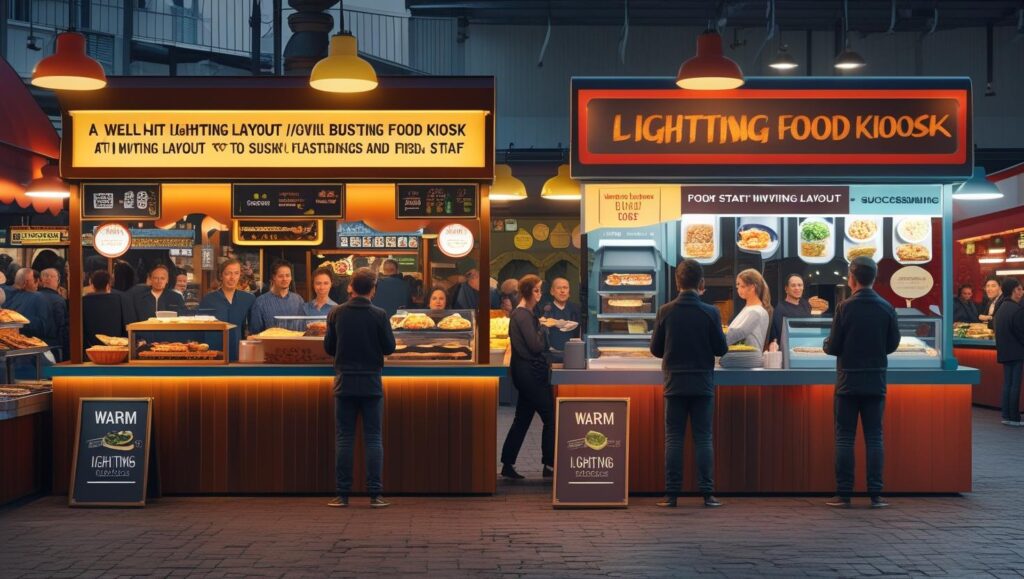In the competitive world of food kiosks—whether nestled inside shopping malls, parks, airports, or street corners—success depends not just on what you serve but how you present it. While flavor and price are obvious factors, two often-overlooked elements significantly influence customer behavior and sales performance: lighting and layout. These subtle yet powerful tools shape customer perceptions, guide their movement, and ultimately determine whether they make a purchase.
1. The Psychology of Lighting: Setting the Mood and Stimulating Appetite
Lighting does more than illuminate—it creates atmosphere, communicates brand identity, and even influences appetite. Here’s how:
-
Warm vs. Cool Lighting:
Warm lighting (yellows and ambers) tends to create a cozy, inviting feel, ideal for comfort foods like baked goods or coffee kiosks. Cool lighting (blues and whites) can suggest cleanliness and freshness, which works well for salad bars, juice stands, or frozen yogurt. -
Spotlighting and Product Focus:
Well-placed spotlights can draw attention to premium items, new products, or seasonal specials. Highlighting menu boards or display cases subtly nudges customers to look—and buy. -
Emotional Triggers:
Brighter environments can energize people and move traffic faster—ideal for busy commuter kiosks. Softer lighting slows customers down, encouraging browsing and more thoughtful (often higher-value) purchases.
2. Strategic Layout: Guiding Customer Flow and Boosting Efficiency
A kiosk’s physical structure plays a huge role in user experience. Thoughtful layout design helps streamline service and maximize visibility.
-
Open vs. Closed Designs:
Open layouts encourage approachability, allowing customers to see offerings before committing. This can reduce hesitation and increase foot traffic. Closed kiosks may offer faster service in high-volume areas but need more visual appeal from the outside. -
Optimizing Counter Space:
Placing impulse-buy items—like beverages, snacks, or desserts—at the front counter or near checkout encourages add-on purchases. -
Queue Management:
Clear entry and exit points help avoid bottlenecks. Simple barriers, floor markers, or rope dividers subtly guide people where to stand, reducing confusion and speeding up service. -
Menu Placement and Visibility:
Eye-level digital or printed menus that are easy to scan—even from a distance—can accelerate decision-making and reduce wait times.
3. Lighting and Layout Working Together: A Sales-Boosting Synergy
When lighting and layout are intentionally designed to complement each other, the results can be dramatic:
-
Zoning with Light:
Use lighting to create “zones” within the kiosk—product highlights, order pickup areas, menu display spots—so customers instinctively know where to look and go. -
Encouraging Exploration:
If your layout allows for customer browsing, such as with self-serve stations or display shelves, light those areas invitingly to entice customers to linger—and spend more. -
Brand Reinforcement:
Cohesive lighting and design help reinforce brand identity. For instance, a trendy smoothie kiosk with vibrant neon accents paired with an angular, modern counter layout visually appeals to younger audiences and signals a fun, social experience.
4. Real-World Results: Case Studies and Observations
-
Mall-Based Kiosks:
Studies show that kiosks with brighter lighting and interactive layouts draw up to 20% more foot traffic than dimly lit, static counterparts. -
Street Vendors with Mobile Carts:
Vendors who install LED-lit signs or display lighting often experience higher nighttime sales—proving that even low-cost lighting solutions can pay off. -
Pop-Up Events:
Kiosks designed for festivals or seasonal markets benefit greatly from mobile layouts and battery-powered lighting, making them flexible and visually impactful even in temporary spaces.
5. Tips for Food Kiosk Owners: Practical Steps to Boost Sales
-
Invest in LED lighting for energy-efficient yet powerful illumination.
-
Test multiple layouts during non-peak hours to observe customer flow and adjust.
-
Use mirrors or reflective surfaces to amplify lighting in small kiosks.
-
Regularly update your lighting schemes and layout to match seasonal menus or promotional campaigns.
Conclusion
Lighting and layout are more than aesthetic choices—they’re strategic tools that directly affect how customers perceive your kiosk, how long they stay, and how much they spend. Whether you’re designing a new kiosk or optimizing an existing one, focusing on these two elements can give you a competitive edge, increase customer satisfaction, and ultimately boost your bottom line.

